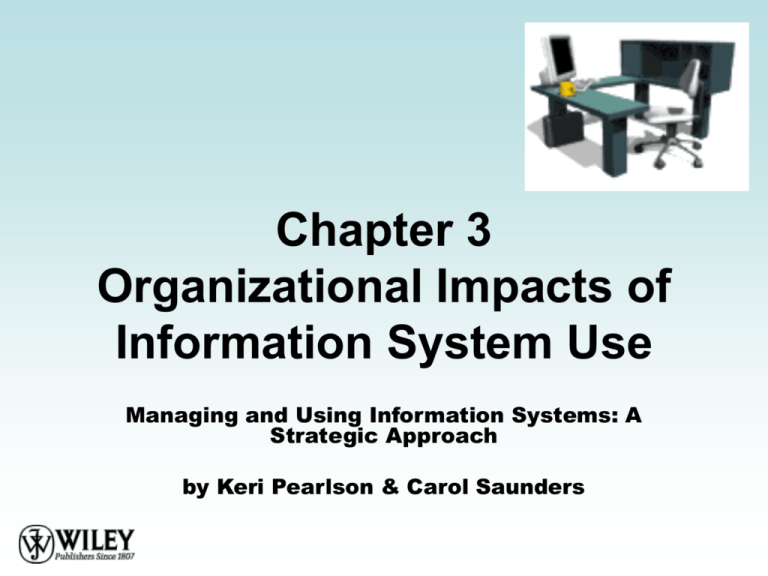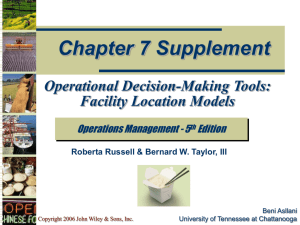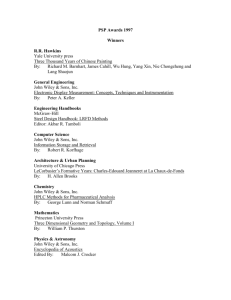
Chapter 3
Organizational Impacts of
Information System Use
Managing and Using Information Systems: A
Strategic Approach
by Keri Pearlson & Carol Saunders
Introduction
• How does the use of information technology
impact the organization?
• What type of organizational structure tends to be
most willing to embrace technological change
and sophistication? Why?
• What are the advantages and disadvantages of
the networked organizational structure?
• How has IT changed the way managers monitor
and evaluate?
• Are virtual organizations just a passing fad?
• What challenges are faced by virtual team?
Copyright 2006 John Wiley & Sons, Inc.
2
Real World Examples
• Diamond Technology Partners (DTP).
– Every consultant has a laptop to permit automatic connectivity
with the corporate intranet.
– Intense use of computers, shared data, extensive electronic
communications foster high levels of interaction & fluid, highly
adaptable work arrangements.
• Mrs. Fields IS focused on sales skills not simply
production.
– Implemented a computer system that automated much of the
baking and planning tasks.
– Employees able to focus on sales not on baking issues.
• IS is fundamental to the way these companies are
organized to do business.
• IS can leverage human resources, capital and materials.
Copyright 2006 John Wiley & Sons, Inc.
3
INFORMATION AGE
ORGANIZATIONS
Key Characteristics
• 1988 three professors at Harvard Business
School predicted what would be key
characteristics of information age organizations.
• Their predictions were close to what happened.
• These predictions can be related to three
categories (Figure 3.2):
– Organizational structure.
– Human resources.
– Management processes.
• Information age organizations use a different
organization structures.
Copyright 2006 John Wiley & Sons, Inc.
5
Variable
Description
Organizational variables
Decision rights
Authority to initiate, approve, implement, and control various types of decisions
necessary to plan and run the business.
Business processes
The set of ordered tasks needed to complete key objectives of the business.
Formal reporting
relationships
The structure set up to ensure coordination among all units within the
organization.
Informal networks
Mechanism, such as ad hoc groups, which work to coordinate and transfer
information outside the formal reporting relationships.
Control variables
Data
The information collected, stored, and used by the organization.
Planning
The processes by which future direction is established, communicated, and
implemented.
Performance measurement
and evaluation
The set of measures that are used to assess success in the execution of plans
and the processes by which such measures are used to improve the quality of
work.
Incentives
The monetary and non-monetary devices used to motivate behavior within an
organization.
Cultural variables
Values
The set of implicit and explicit beliefs that underlie decisions made and actions
taken.
Figure 3.1 Organizational design variables.
Copyright 2006 John Wiley & Sons, Inc.
6
Dimension
Characteristics
Organizational Structure
Companies have benefits of small and large scale
simultaneously.
Lg. organizations adopt flexible/dynamic structure
Centralized/decentralized control blur
Focus on projects/process vs. tasks/procedures
Human Resources
Workers better trained, autonomous, transient
Work environment exciting, engaging
Management shared, rotated, even part-time
Job descriptions tied to defined tasks non-existent
Compensation tied directly to contribution
Management Processes
Decision-making is well understood
Control separated from reporting relationships
Computers support creativity at all levels
IS retain corp. history, experience, expertise
Figure 3.2 Key characteristics for the Information Age organization
Copyright 2006 John Wiley & Sons, Inc.
7
INFORMATION TECHNOLOGY
AND ORGANIZATIONAL
DESIGN
Copyright 2006 John Wiley & Sons, Inc.
8
IT & Organizational Structures
• Traditional organizations are hierarchical, flat or matrix in
design (Fig. 3.3).
• In hierarchical orgs. middle managers tell subordinates
what to do and tell superiors the outcomes. IS supports
this hierarchy.
• In flat structured orgs. work is more flexible and
employee do whatever is needed. IS allows offloading
extra work and supports intra-firm communications.
• In matrix organizations, work is organized into small work
groups and integrated regionally and nationally/globally.
– IS reduces operating complexes and expenses by allowing
information to be easily shared among different managerial
functions.
Copyright 2006 John Wiley & Sons, Inc.
9
Figure 3.3 Hierarchical, flat, and matrix organization structures.
Copyright 2006 John Wiley & Sons, Inc.
10
Hierarchical Organizational Structure
• Based on the concepts of division of labor,
specialization, and unity of command
• Key decisions are made at the top and filter
down through the organization
• Middle managers do the primary information
processing and communication function
• IS is typically used to store and communicate
information along the lines of the hierarchy
and to support the info management function
of the managers
Copyright 2006 John Wiley & Sons, Inc.
11
Flat Organizational Structure
• Decision-making is centralized
• As everyone does whatever needs to be
done, they can respond quickly to dynamic,
uncertain environments
• However, this organizational structure often
becomes less flexible as the org. grows
• Routine IS work is often off-loaded but, as a
hierarchy develops, becomes the ‘glue’ tying
parts of the organization that would not
otherwise communicate
Copyright 2006 John Wiley & Sons, Inc.
12
Matrix Organizational Structure
• This typically assigns workers with two or
more supervisors in an effort to make sure
multiple dimensions of the business are
integrated, with each supervisor directing a
different aspect of the employee’s work.
• Matrix organizations often fail to enable
managers to achieve their business
strategies because of the inability to cope
with increased information processing
demands
Copyright 2006 John Wiley & Sons, Inc.
13
Networked Organizational Structure
• “Rigid hierarchies are replaced by formal and
informal communication networks that connect
all parts of the company.”
• Defined by their ability to promote creativity and
flexibility while maintaining operational process
control, which is achieved by substituting
hierarchical controls with controls based on IS
• Extensive use of communication technologies
and networks also makes it easier to coordinate
across functional boundaries
Copyright 2006 John Wiley & Sons, Inc.
14
Hierarchical
Flat
Matrix
Networked
Description
Bureaucratic w/
defined levels of
management
Decision-making
pushed down to
lowest level
Workers assigned
to 2 or more
supervisors
Formal/informal
communication
networks that
connect all
Known for flexibility
and adaptability
Characteristics
Division of labor
specialization,
unity of command
Informal roles,
planning and
control; often
sm.,young orgs.
Dual reporting
based on
function/purpose
Type of
Environment Best
Supported
Stable
Certain
Unstable
Uncertain
Unstable
Uncertain
Unstable
Uncertain
Basis of
Structuring
Primary function
Networks
Primary function
Functions and
purpose
Power Structure
Centralized
Centralized
Distributed
Distributed
Key Tech.
Supporting this
Mainframe,
centralized data
and processing
Personal
computers
Networks
Intranets and
Internet
Figure 3.4 Comparison of Organizational Structures
Copyright 2006 John Wiley & Sons, Inc.
15
Figure 3.5 The networked organization.
Copyright 2006 John Wiley & Sons, Inc.
16
T-Form Organization
• T-form (“technology-based”) organizations
take the networked structure one step further
by combining IT with traditional components
to form new types of components
• These include electronic linking, production
automation, electronic workflows, electronic
customer/supplier relationships and selfservice Internet portals
• Work is often coordinated electronically, while
systems enable information to more easily
move around the organization, and
decentralizing decision-making
Copyright 2006 John Wiley & Sons, Inc.
17
INFORMATION TECHNOLOGY
AND MANAGEMENT
CONTROL SYSTEMS
Copyright 2006 John Wiley & Sons, Inc.
18
Management Control
• IT profoundly affects the way managers control
their organizations.
• People and processes are monitored in ways
that were not possible only a decade ago.
• The activities of management control are
summarized in figure 3.6
• Depending upon the organizational structure will
determine the level of control that a manager
must exercise over their employees.
• IS play three important roles in management
control processes
– Collection, Communication, and Evaluation.
Copyright 2006 John Wiley & Sons, Inc.
19
Control Activities
Brief Definition
Monitoring
Observing and keeping track of the progress, quality,
cost, time and other relevant parameters
Evaluating
Comparing the data collected through monitoring to
standards or historical data.
Providing Feedback Communicating the results of evaluation to the
individuals responsible for the activities and tasks.
Compensating
Deciding on salary or other forms of payment to those
individuals who preformed the tasks.
Rewarding
Deciding and delivering bonuses, recognition, or other
types of prize for exemplary work.
Figure 3.6 Model of management control activities.
Copyright 2006 John Wiley & Sons, Inc.
20
IT Changes Management
Functions
• IT changes the way managers:
– Monitor: IS makes possible new ways to track
performance and behavior
– Evaluate: models are easily built, making it easier to
understand progress and performance
– Provide Feedback: IS makes rapid feedback
possible (e.g., through electronic forms)
– Compensate & Reward: team-based efforts can be
evaluated and complex formulas used
– Control Processes: IS also used extensively in
industrial processes, and makes it easier to collect,
analyze and move information
Copyright 2006 John Wiley & Sons, Inc.
21
VIRTUAL ORGANIZATIONS
Copyright 2006 John Wiley & Sons, Inc.
22
Virtual Organizations
• IT has made it possible for an individual to
work for an organization and live anywhere
• Virtual organization structure is “networked”.
– Extensive collaboration takes place electronically
(e-mail).
• Managers in a virtual environment monitor
results, not progress
• Forms are electronic, tech. support through a
web interface
• Business processes are designed differently.
Copyright 2006 John Wiley & Sons, Inc.
23
Virtual Teams
• Virtual Teams are geographically and/or
organizationally dispersed coworkers assembled using
telecommunications and IT to accomplish an
organizational task.
• Several reasons explain their growing popularity:
– As information needs mushroom, firms rely on the skills and
knowledge of individuals dispersed across countries/time
zones, etc
– Enhanced bandwidths promote the use of networks linking
individuals, internal and external to the organization
– Technology (group support systems, groupware, etc) is
available to assist collaboration
– Difficulties in getting relevant stakeholders together physically
are relaxed
– Growing pressures for off-shoring has resulted in systems
development by global virtual teams whose members are
located around the world.
Copyright 2006 John Wiley & Sons, Inc.
24
Challenges
Virtual Teams
Traditional Teams
Communications Multiple Zones can lead to greater Teams are collocated in same
efficiency but can lead to
communication difficulties.
time zone. Scheduling is less
difficult.
Communication dynamics such as Teams may use richer
non-verbal are altered.
communication media.
Technology
Team Diversity
Team members must have
proficiency across a wide range of
technologies.
Technology is not critical and tools
not essential for communications.
Technology offers electronic
repository.
Electronic repositories are not
typically used.
Work group effectiveness may be
more dependent on alignment of
group & technologies used.
Task technology fit may not be as
critical.
Members typically come from
different organizations and/or
cultures which makes it:
Because members are more
homogeneous, group identity is
easier to form.
-Harder to establish a group identity.
-Necessary to have better com. skills
-More difficult to build trust, norms …
Because of commonalities,
communications are easier to
complete successfully.
Figure 3.7 Comparison of challenges facing virtual and traditional teams.
Copyright 2006 John Wiley & Sons, Inc.
25
FOOD FOR THOUGHT:
IMMEDIATELY RESPONSIVE
ORGANIZATIONS
Copyright 2006 John Wiley & Sons, Inc.
26
Immediate Responsive
Organizations
To accomplish the goal of instant “customization”,
an organization must master five disciplines:
1.
2.
3.
4.
5.
Instant value alignment – ready to provide exactly what the
customer wants
Instant learning –building learning directly into the company’s
tasks and processes
Instant involvement – using IT to ensure that everyone is ready
to deliver products, services, etc
Instant adaptation – creating the culture to support this
Instant execution – During It to cut cycle times to appear
instant to the customer
Copyright 2006 John Wiley & Sons, Inc.
27
SUMMARY
Copyright 2006 John Wiley & Sons, Inc.
28
Summary
• IS must be a key component of organizational design.
• Organizational designers must have an understanding of
what IS can do.
• The flow of information can inhibit or facilitate organization
structures.
• Virtual and networked organizations are rising in use and
are replacing older legacy structures.
• IT affects managerial control mechanisms and managers
must ensure that these controls are in place.
• Virtual organizations make it possible for employees to live
anywhere.
• Virtual Teams are increasing in frequency and the
challenges that they pose must be addressed.
Copyright 2006 John Wiley & Sons, Inc.
29
• Copyright 2006 John Wiley & Sons, Inc.
•
All rights reserved. Reproduction or translation of this work beyond that
named in Section 117 of the 1976 United States Copyright Act without the
express written consent of the copyright owner is unlawful. Request for
further information should be addressed to the Permissions Department,
John Wiley & Sons, Inc. The purchaser may make back-up copies for
his/her own use only and not for distribution or resale. The Publisher
assumes no responsibility for errors, omissions, or damages, caused by the
use of these programs or from the use of the information contained herein
Copyright 2006 John Wiley & Sons, Inc.
30







